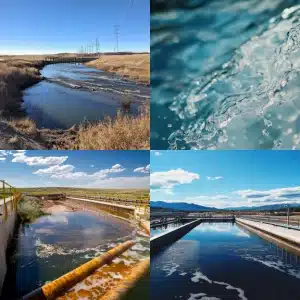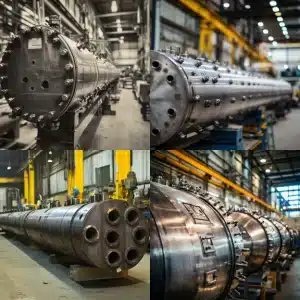High EPA levels indicate emissions or pollutants exceeding safety standards, posing risks to the environment, worker safety, and business compliance. Red River helps businesses monitor, reduce, and manage EPA levels to maintain regulatory compliance and operational efficiency.
What does high EPA Levels indicate?
Meeting environmental standards is crucial, particularly regarding high EPA levels for Red River. Whether it’s related to oil and gas, power generation, or commercial projects, understanding what high EPA levels mean is vital. Elevated EPA readings can affect your operations, requiring adjustments to ensure safety and compliance. To stay ahead, understanding the causes and solutions for high EPA levels is key, especially when using pressure vessels or modular skids.
Defining EPA and Its Role in Environmental Standards
The Environmental Protection Agency (EPA) plays a major role in setting safety and environmental standards for industrial operations. Specifically, high EPA readings mean harmful emissions or pollutants exceed acceptable levels, posing risks to your business and the environment.
For example, in pressure vessel manufacturing, materials with high VOC or HAP content can lead to elevated readings. Controlling emissions ensures compliance with ASME-certified pressure vessels standards and maintains industry-leading safety.
What are Causes of High EPA Levels in Industrial Operations?
High EPA levels in industrial settings often result from outdated equipment, inefficient processes, improper waste handling, or lack of employee training. Using older materials or substandard fabrication methods can raise EPA readings. Early intervention helps keep operations within regulatory limits.
How Do High EPA Levels Affect Compliance and Regulation?
Elevated EPA levels indicate non-compliance with regulations, potentially leading to fines, shutdowns, and reputational damage. Failure to meet EPA standards compromises safety and regulatory adherence, impacting your bottom line. Partnering with Red River solutions ensures your operations meet compliance from the start, maintaining both safety and efficiency.
How High EPA Affects Your Business Operations
High EPA levels directly affect operational safety and efficiency. Typically, higher readings are linked to greater environmental risks, requiring immediate action to prevent disruptions. At Red River, we help businesses lower their EPA scores through state-of-the-art fabrication methods, ensuring compliance while maintaining productivity.
Why Monitoring EPA Levels Is Important for Safety
Monitoring EPA levels protects both your workforce and the environment. It helps identify hazardous conditions early, avoiding accidents or long-term health risks. Regular audits and emissions tracking ensure your operations remain within safe and legal limits.
Possible Hazards If You Neglect High EPA Levels
Ignoring high EPA levels can lead to fines, lawsuits, or operational shutdowns. Employees may be exposed to hazardous conditions, and your company’s reputation can suffer. Maintaining compliance with Red River protects both your workforce and your business through proper pressure vessel design.
Case Studies: Actual Cases of High EPA Impact
We have dealt with clients who had suffered a serious business impact from non-compliance with EPA standards. From expensive fines to shutdowns, the effects of high EPA readings have been very real indeed. At Red River, we will help your business remain compliant and thrive through a competitive environment.
Managing and Reducing High EPA Solutions
Managing and reducing EPA levels is critical for long-term business survival. Red River uses high-technology manufacturing and ambient surface-to-beam scrubs to ensure pressure vessels exceed EPA requirements. Employing eco-friendly materials and advanced fabrication techniques keeps emissions low while maintaining efficiency.
What are Some Proven Ways to Reduce EPA in Manufacturing?
Perhaps most important, high technology manufacturing can reduce EPA levels. We here at Red River use state-of-the-art fabrication methods with little or no emissions and waste.
To top all that off, with surface-to-beam ambient scrubs, we ensure your pressure vessels are manufactured according to or exceeding the requirements of the EPA.
Best Practices for Continued High EPA Levels Monitoring and Compliance
Maintaining compliance with high EPA levels requires ongoing vigilance. Red River helps clients implement continuous audits, advanced monitoring technology, and team training to avoid penalties and ensure long-term operational safety. By proactively managing high EPA levels, your business can protect employees, maintain regulatory compliance, and optimize environmental performance.
Need a reliable partner?
Red River specializes in design and manufacturing of pressure vessels, prefabricated spools, and modular skid packages. Reach out through our contact page to experience the Red River difference, where American-made quality meets industry-leading solutions.
Frequently Asked Questions
1. What Does the EPA Control in Industrial Manufacturing?
The EPA rules control various aspects of industrial manufacturing, which include hazardous pollutant emission, air as well as water quality, and proper waste material handling. During the production of pressure vessels, for example, EPA standards are necessary to ensure that harmful chemicals and emissions are controlled to the lowest level. Such restrictions help reduce the impact of industrial activities on the environment, hence safeguarding both the health and safety of workers and communities near industrial sites. All these regulations should be followed to avoid incurring any penalties and to ensure smooth operation.
2. How Might Extremely High Levels of EPA Increase the Costs Associated with Operating a Manufacturing Facility?
High EPA levels significantly affect the cost of operating a facility. Not meeting EPA standards incurs fines and penalties along with the mandated shutdowns that result in cost-effective delays. The cost of overcoming non-conformity includes installing new equipment or embracing new processes, which again is steep. It can also save money in the future through lower energy consumption, waste generation, and possible breach issues if the investment goes in reducing the levels of EPA.
3. What Are Some Things That Businesses Can Do to Lower Their EPA Levels?
Businesses should reduce their EPA levels by following the following practices:
- Select energy-efficient processes: Businesses can upgrade to the most up-to-date machinery that can be proven to release fewer emissions.
- Emissions tracking: Businesses should regularly check their emissions with advanced tracking tools so that the levels are kept within the safe range.
- Employee training: Businesses must train their employees on some of the best environmental practices to reduce errors that may contribute to the increase in EPA levels.
Applying eco-friendly materials and technologies that have the purpose of reducing, during manufacturing processes, the ecology load contributes not only to compliance but also to improvements in operational efficiency.
4. What Are Some Common Causes of Increased Levels of EPA in Industrial Environments?
Some common causes of increased levels of EPA in industrial environments include:
- Old Equipment: Older equipment cannot support current emission standards, and thus the EPA level will go up.
- Lack of Maintenance: Maintenance of equipment is not properly done, leading to inefficiencies that often result in increased emissions and waste.
- Uneducated Workers: Workers are not educated or informed about compliance procedures, causing the EPA to rise unknowingly due to improper equipment use or substandard materials.
- Improper Handling of Materials: Certain raw materials, when dealt with incorrectly, result in emissions or higher pollutant discharges.
5. How Do Pressure Vessels Contribute to a High EPA Reading and How Is It Controlled?
Pressure vessels are known to generate a high EPA reading due to the materials used in their manufacture and, indeed, how they are fabricated. For example, emissions can be produced due to the welding process and other high-heat fabrication processes. Some coatings and materials are VOC-emitting. Manufacturers should ensure to use environmentally friendly materials, ensure that the production environment is well-ventilated, and maintain stringent quality control standards to minimize emissions during production.
Key Takeaways
- Elevated EPA levels signal non-compliance and can lead to fines, shutdowns, and reputational damage.
- Causes include outdated equipment, poor maintenance, inefficient processes, and improper material handling.
- Monitoring and proactive management of EPA levels protect employees, the environment, and business operations.
- Solutions include upgrading technology, emissions tracking, employee training, and using eco-friendly materials.
Related Blog Post
- Conductivity Levels in Drinking Water: Why They Matter for Safety and Industry
- Common Signs Your Drinking Water May Be Unsafe | Red River
- Understanding Unregulated Drinking Water Sources | Red River
- Knowing Safe Drinking Water Standards | Red River
- Why Drinking Water Quality Standards Matter | Red River
- Understanding EPA Contaminants and Their Impact | Red River




